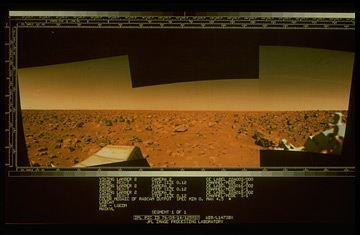
Surface of Mars taken from Viking I
July 20, 1976 and Sept. 3, 1976 — Mars is an awfully hard place to get to, which the U.S. and U.S.S.R. proved, having fired a fusillade of 20 different probes toward the Red Planet since 1960, missing or crashing more often than succeeding. A few ships did manage to orbit Mars successfully, and one, the Soviets' Mars 3 probe, even landed in 1971, but its camera quit after 23 seconds. Vikings 1 and 2, both of which consisted of a paired orbiter and lander, finally got it all right. With an eye for historical symmetry, NASA planned the first landing to coincide with the seventh anniversary of Apollo 11, but when the stunning, full-color images of the desert-like Martian surface began streaming in, Apollo's earlier moon triumph was all but forgotten. The Vikings also conducted the first test for Martian life, dripping caustic chemicals on a sample of soil and looking for telltale signs of reaction with organic materials. Some critics pointed out that if life in fact did exist on Mars, Viking had just killed it. There turned out to be no need for such worries though; the tests turned up nothing.